
New Seeley Theatre and Opera House (Site ID 56)
Current (2021) address: 67 S Seventh St
1953 address: 564 3rd, Telephone 109
Classification: Historic Contributing
This lot was originally the site of Burlingame Hall (erected in 1879, moved in early 1913, and demolished in 1935) that was used by the community for gatherings, dances, and other events such as prize fights, plays, and wrestling. The old hall was moved to Seventh and Columbia streets when the New Seeley Theatre and Opera House was erected by Charles H. Seeley. Plans for the construction of the new theatre began in 1911. Well known Seattle architect E.W. Houghton was hired to design the new modern building; the design for the new Seeley Theatre was similar to Seattle's famous Moore Theatre. Completed in 1913, the theatre opened on 24 November 1913 with over 700 people in the attendance to see the London play "Bunty Pull the Strings." Claude and Abbie Thompson were managers of the theatre at that time.
A hand-painted advertising screen, or oleo (still intact as of the nomination in 2002) rolled down to conceal the stage, and advertised Pomeroy's businesses. The Wurlitzer Orchestra & Photo player graced the orchestra adding to the evening's performances. Abbie Thompson continued to operate the theatre after her husband's death in the early 1920s, and in 1929, updated the theatre with new carpets, drapes, restrooms, and by enlarging the projection room to accommodate the equipment necessary to play "talkies." The first talkie, "Fast Company," was shown in October 1929.
Abbie Thompson eventually purchased the theatre and ran the business until January 1950 when she sold to Seeley's grandson, Seeley Allen. In the 1950s, the box seats were removed to install a wide screen for cinemascope films. The first Technicolor film, "Red Skies of Montana" was shown on 24 January 1952. Allen sold the theatre in 1955 to Floyd and Mary Koberstein who modernized the lobby. The last movie of the time at the theatre was shown in the 1960s. When the theatre business failed, a refrigeration and repair shop used the stage portion of the theatre.
The commercial space in the building was used as a tailor's shop from 1913 to the 1920s, photography gallery in the 1920s and 1930s, a beauty shop from the 1920s through the 1940s, and a shoe repair in the 1950s to 1962.
The theatre was purchased by Zack Lueck and two partners in 1980 and he was able to show movies through much of the 1990s. He also operated an antiques and used book store through the early 2000s.
The three and one-half story brick building has a hip roof, wide overhanging eave on the front elevation supported by massive wood brackets sheltering wooden casement windows, and two brick square towers with a decorative brick frieze flank the central bay on the west (front) elevation. The brick spandrel above the balcony windows are embellished with raised brick in a geometric pattern. The balcony has been enclosed with multi-pane vinyl windows and boarding; the original French doors are behind the enclosure. A wide brick Sullivanesque arch covers the recessed double entrance doors. Windows on the front elevation are a combination of larger fixed-pane windows and smaller multi-pane casements.
The arch is constructed of buff colored brick that contrasts with the red brick exterior. The side elevations are articulated with raised brick pilasters on the upper story that create rectangular panels. Multiple service/stage doors are on the side and rear elevations. The rear elevation (east) is taller than the front of the theatre to accommodate the height of the interior stage. An outside garden is south of the building and the alley is to the north.
Description and much of the Cultural Data based on
research by Donovan & Associates

That's the Burlingame or Seeley Hall behind the Cardwell Building. In a manner similar to the original St. George Hotel, the big boxy Hall was picked up and carried to the corner of (then) 3rd street and Columbia. (Photo courtesy of Alverna (Al) Godinez.
Here's a notice from the November 15, 1913, East Washingtonian:
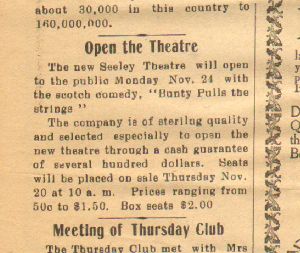
Open The Theatre
The new Seeley Theatre will open to the public Monday Nov. 24 with the scotch comedy, "Bunty Pulls the strings."
The company is of sterling quality and selected especially to open the new theatre through a cash guarantee of several hundred dollars. Seats will be placed on sale Thursday Nov. 20 at 10 a.m. Prices ranging from 50¢ to $1.50. Box seats $2.00
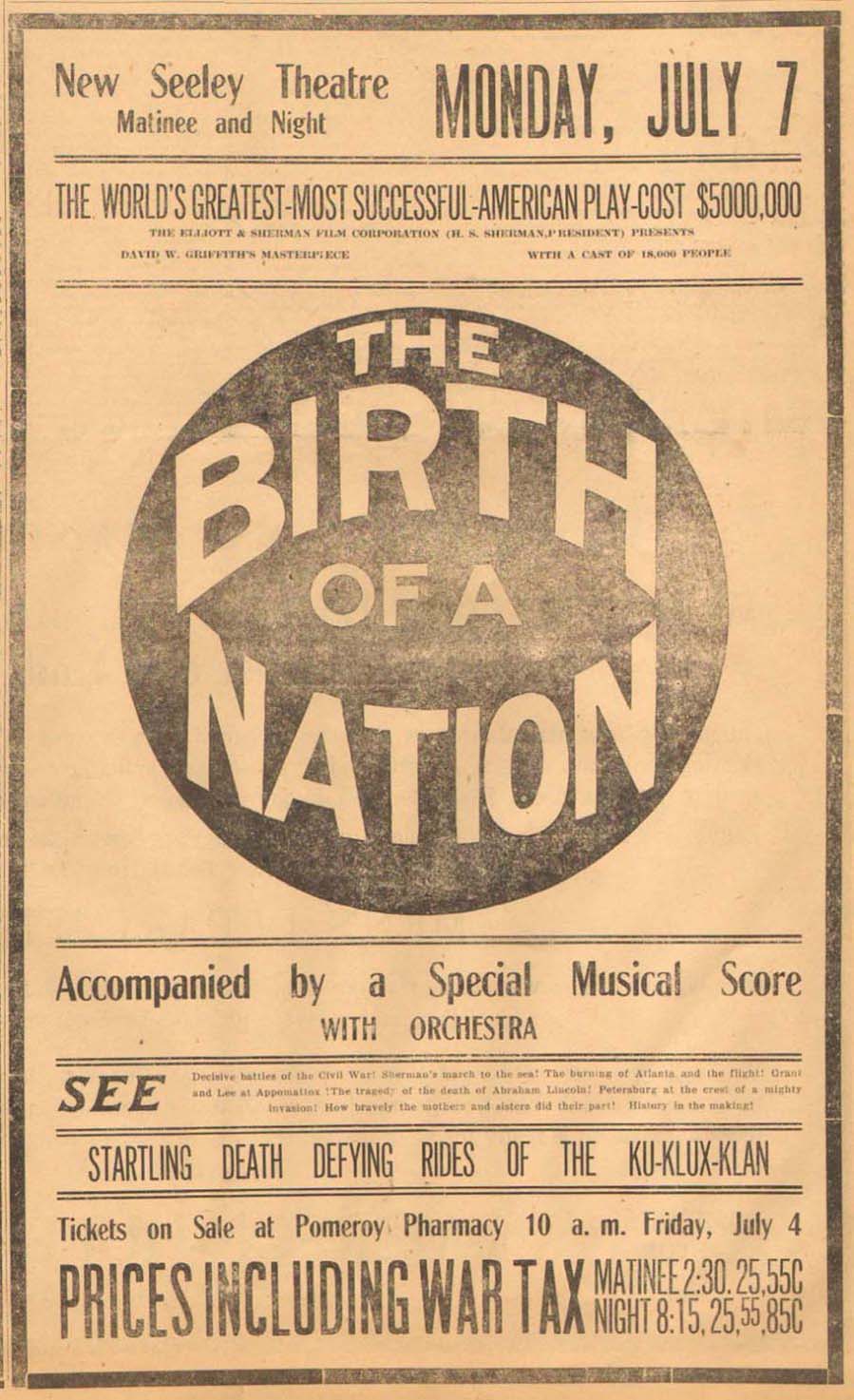
"The Birth of a Nation" was released in 1915. It made it to Pomeroy and the Seeley Theatre in the Summer of 1919. This was a large advertisement taking up over 75% of a (large) page in the East Washingtonian.
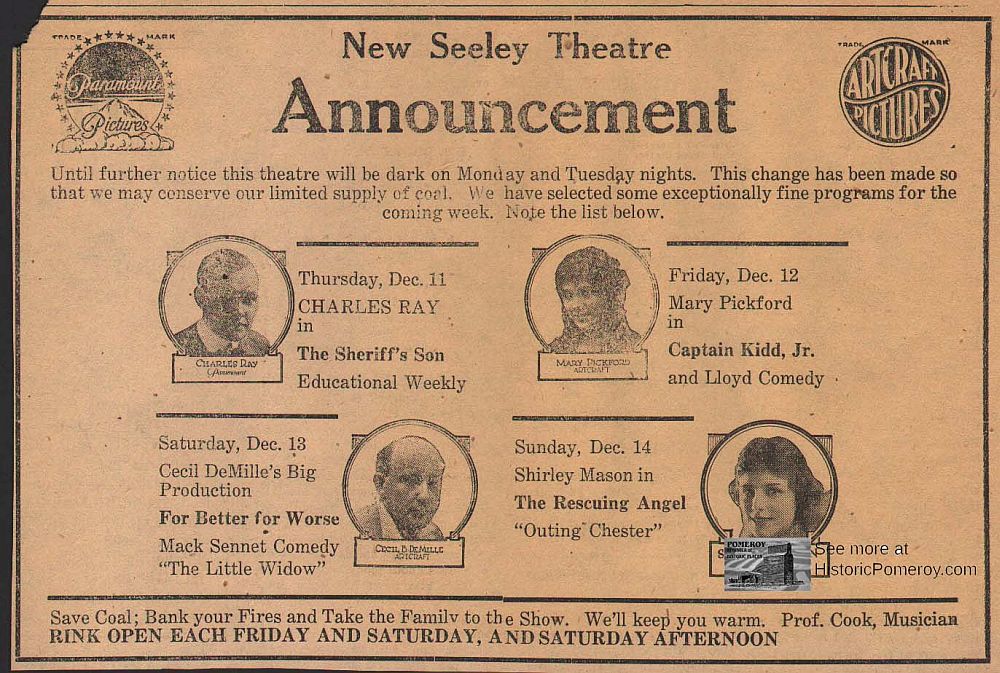
We ran out of coal in 1919, following the War to End Wars. Seeley was now closing on Mondays and Tuesdays.
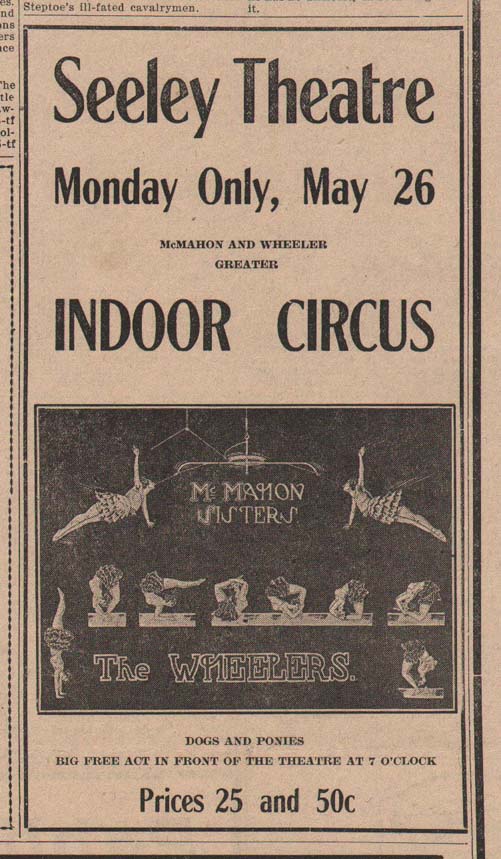
May 1924. Come to an "Indoor Circus" at the Seeley.
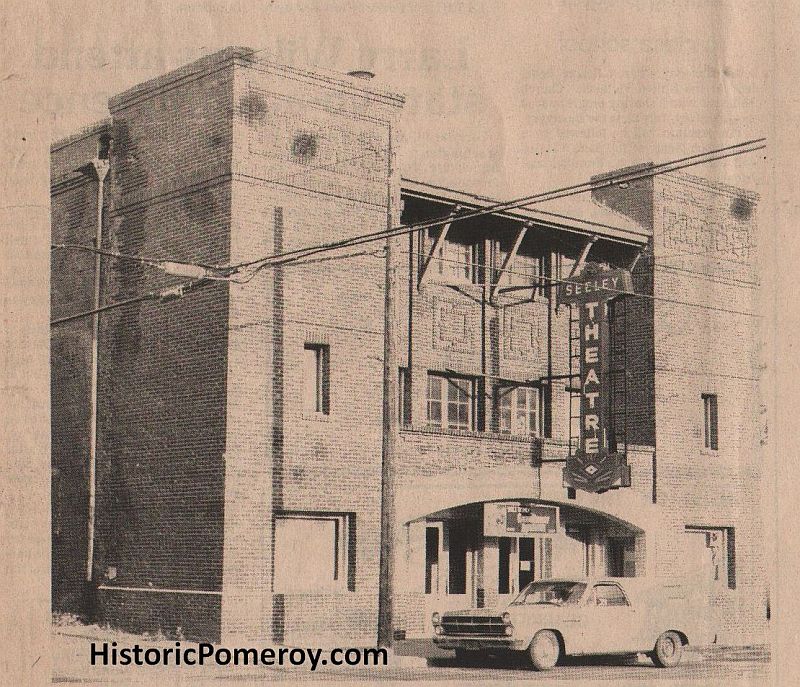
This photo, probably taken by Mike Denuty, shows the Seely with its vertical sign taken in the Summer of 1980.
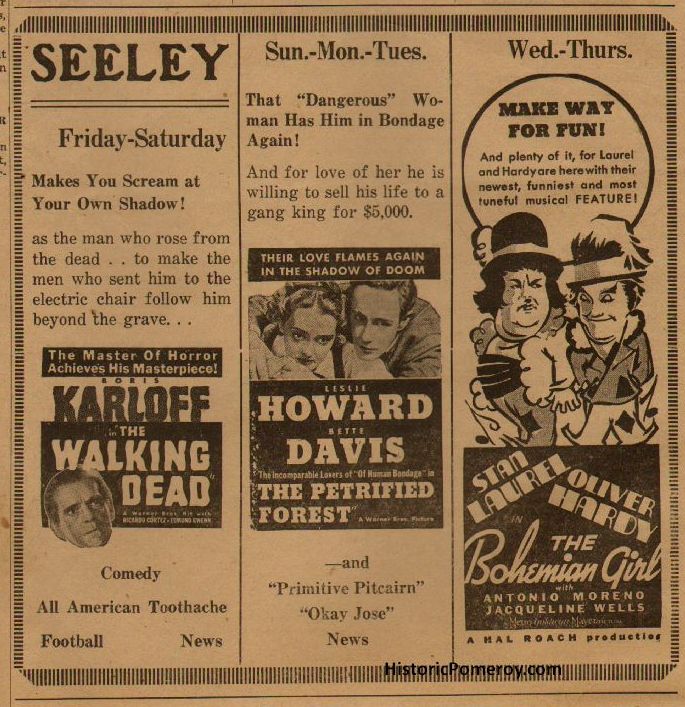
Karloff, Bette Davis, Laurel and Hardy were here in 1936.
From August, 1957, this article showing how the community has supported the theatre for a long time:
Save the Theatre Success So Far
Attendance at the Seeley theatre has increased considerably since the "Save Our Theatre" nights were started on February 7 of this year [1957], it was reported at a meeting of the Chamber of Commerce theatre committee Wednesday evening.
The nights were started because the town was destined to lose the theatre because of poor attendance.
The jackpot money offered each Thursday evening is put up by the owners of the theatre, Mr. and Mrs. Floyd Koberstein. The two $5.00 credit or merchandise certificates given each week are donated by local merchants or individuals.
The committee would like to keep the plan going for a few more months at least because it appears to be a success. They are now wondering if more individuals would like to donate a certificate.
Almost all the merchants and businessmen in Pomeroy have given one or more of the certificates and since this is a county-wide project it was thought an appeal should be made to individuals or families.
Several residents of the county not engaged in business in Pomeroy have already given a certificate. If any others would care to they can contact Burt Belknap, chairman of the chamber theatre committee.
A December 17, 1959, article in the EW covered Santa's arrival at the Seeley. I've added this picture and article because it shows the frame to the left side of the entrance arch used for holding playbills.
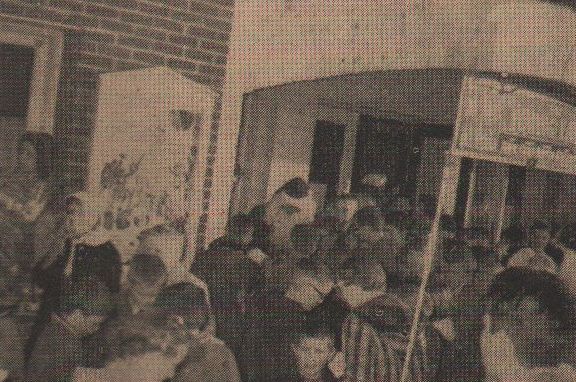
JOLLY OLD SANTA—Pictured above are just a few of the 407 youngsters who attended the free motion picture show Saturday afternoon sponsored by the Pomeroy Chamber of Commerce for the boys and girls of the county. Santa is shown, assisted by members of the Junior Chamber of Commerce, handing out treats to the youngsters as they were dismissed at the conclusion of the afternoon's entertainment. Saturday's crowd was the largest of two such events already held to date. The first show on Saturday, Dec. 5 was attended by 393 youngsters. Another big crowd is expected to be on hand Saturday, Dec. 19, the last of such Christmas events for this year.
From an article in the November 24, 1960, issue of the E-W:
Theater To Open For Free Movies
Even though Pomeroy's theatre is closed, the Pomeroy Chamber of Commerce announced this week that during two Saturdays of their Christmas program the local children will still have their Saturday afternoon movies.
Ferd Herres, chairman of the chamber Christmas program, said that Mr. and Mrs. Floyd Koberstein have agreed to run the free movies on the Saturdays of Dec, 10 and 17 for children through grade school. Other arrangements for the theatre during the Yule season are pending.
Herres said the Christmas season will get its official opening Monday, Nov. 28, when many of the Pomeroy merchants will run several specials and remain open until 9 p. m. to accommodate Christmas shoppers.
Santa will make his first visit to Pomeroy Friday, Dec. 2, with stopovers at several Main street business houses to have pictures taken with the hundreds of children who turn out to see him.
The "Bonus Bucks" prizes that were initiated last year were so well received that the Christmas committee has agreed to run them again this year at each of the drawings. Four $25 "bonus bucks" packages will be given at the first drawing Dec. 5. The same program will be carried through to the children at the free movies who will also draw for the cash prizes. Herres said the "bonus bucks" have to be redeemed by Dec. 24 or they become void.
Herres commented that some mention has been made as to whether local merchants and their families are eligible to receive tickets for the Saturday drawings. He said the committee has discussed the situation and decided that the program is designed to keep shoppers in Pomeroy and they are as eligible as anyone else.
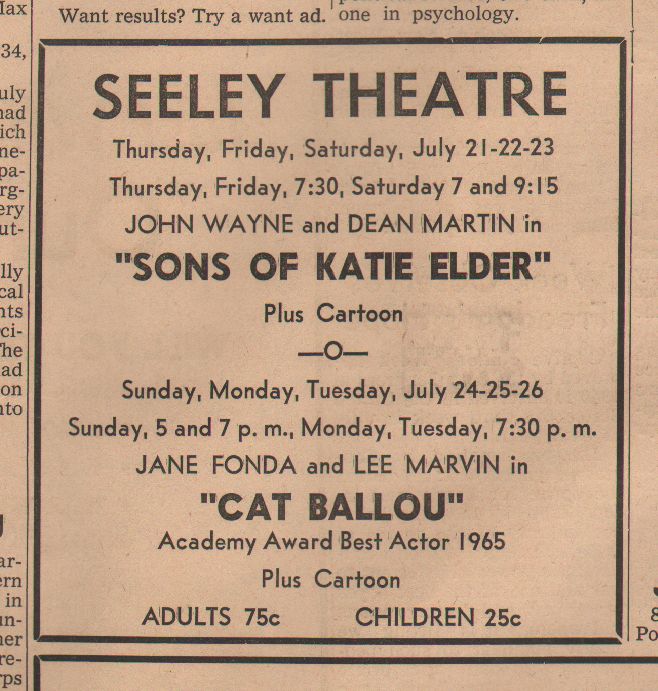
Summer of 1966.

October, 1979, Hey there. . . Wanna buy a theater?
An announcement is made in the July 7, 1980, East Washingtonian:
Kobersteins end 25 years as Seeley Theatre owners
After operating the Seeley Theatre for the past 25 years, Mr. and Mrs. Floyd Koberstein will hand over the reins after this weekend's presentation.
The new operators of the threatre will be Zack and Sharon Lueck and Gerald Compton, all of Spokane.
The Kobersteins started operating the theatre on Halloween night in 1955. It was a free show, sponsored by the Eagles Lodge and 250 kids came dressed up in costumes. Some came dressed as scarecrows, while others came dressed in cardboard box costumes, and could hardly get into the seats, Mary recalls. A prize was given for the best costume.
The Halloween night show was continued for several years before it was discontinued, but the Koberstein's first one was memorable because later that evening the temperature plummeted and the pipes in the theatre froze. Floyd and Mary say they hope the new owners don't start off with such a bang! "We were initiated in a real tough way," Mary said.
They purchased the show from Seeley Allen, who had converted it to Cinemascope operation shortly before he sold it. The theatre has the same equipment today. Except for a few theatres that offer film projection completely around a circular theatre, the equipment used at the Seeley is the same used at most theatres around the country. Over the years, however, the Kobersteins have made several other improvements, including new seating and carpeting. In 1967, they moved the bathrooms downstairs, remodeled the lobby and closed the balcony.
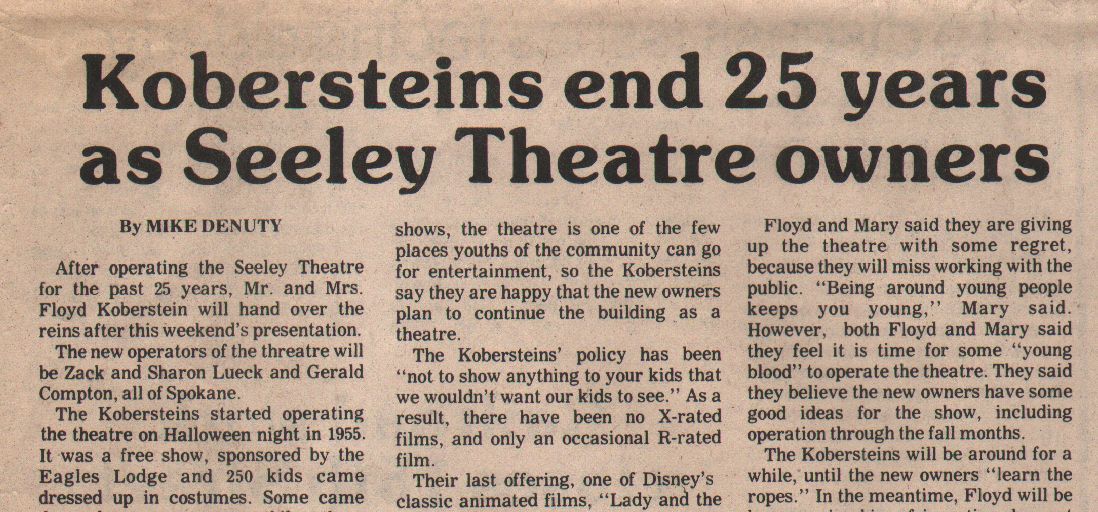
The Kobersteins remember catching two small boys writing on the bathroom walls. Instead of turning the boys in, the Kobersteins asked them to paint the room. One accepted, but the other balked. However, he eventually consented, and when they were finished they were permitted to initial their work. One of the boys, now grown, recently talked with the Kobersteins and told them the painting project was the best lesson he ever learned.
When Floyd and Mary first started operating the theatre, they operated daily. Gradually, this was reduced to the present operation of three days each week. However, Mrs. Koberstein said the potential may now be here to resume operations a fourth night each week.
The children who came to the show in those early years are now the parents of shows, the theatre is one of the few places youths of the community can go for entertainment, so the Kobersteins say they are happy that the new owners plan to continue the building as a theatre.
The Kobersteins' policy has been "not to show anything to your kids that we wouldn't want our kids to see." As a result, there have been no X-rated films, and only an occasional R-rated film.
Their last offering, one of Disney's classic animated films, "Lady and the Tramp," characterized what they have tried to do—provide quality entertainment.
Mrs. Koberstein said she hopes teenagers and adults won't ignore the film because it is animated. She remembers it as a love story with humor, heroism and lots of excitement. "We are proud to otter it as our last presentation." The show was new 25 years ago and was one of the last shown by Seeley Allen.
Floyd and Mary said they are giving up the theatre with some regret, because they will miss working with the public. "Being around young people keeps you young," Mary said. However, both Floyd and Mary said they feel it is time for some "young blood" to operate the theatre. They said they believe the new owners have some good ideas for the show, including operation through the fall months.
The Kobersteins will be around for a while, until the new owners "learn the ropes." In the meantime, Floyd will be busy moving his refrigeration shop out of the building. It has been located in the back of the theatre for many years, but Floyd will now move it into his garage.
Mr. and Mrs. Koberstein said they appreciated the support of the public over the past 25 years, but many residents, on hearing news of the sale, said they appreciated what the Kobersteins have done. . .many communities the size of Pomeroy, or larger, no longer have a theatre of any kind.
From an article in the summer 1980, issue of the E-W:
New theatre operators slate first presentation Saturday
The new owners of the Seeley Theatre will present "The Electric Horseman" as their first presentation, this Saturday, Sunday and Monday, at 7:30 p.m.
The movie is a romantic adventure starring Robert Redford as an ex-rodeo champ who kidnaps a multi-million dollar horse. Jane Fonda, as the network newscaster who follows him to find out why he stole the horse, also stars. Valerie Perrine and country music star Willie Nelson co-star. The film is rated PG—parental guidance suggested.
This will be the first show presented by Zack and Sharon Lueck and Gerald Compton, who have purchased the theatre from Floyd and Mary Koberstein. Next week's feature is "Alien."
Zack Lueck is the dining room manager of the Saddle Rack in Spokane and his wife also worked there until she had her baby last winter. The third partner, Jerry Compton, also works there.
The Luecks say they intend to spend about half of their time in Pomeroy, and with three partners at least one will be here almost all the time. Zack's brother Doug may also be helping out at times, they said.
Present plans are to keep the theatre open until around Christmas, closing it during basketball season in January, February and the first part of March. They say they may take a survey later to find out if people want a second showing of some films, such as a later showing during harvest. Also, they will review other scheduling possibilities, but for now the shows will continue to begin at 7:30 p.m. on Saturdays, Sundays and Mondays.
Lueck showed part of the movie by himself Monday night, as Floyd Koberstein left the projection room for a time, to give him the experience. After the movie was over, Zack said there is a lot more to operating a theatre than he had suspected.
The new owners plan a gradual remodeling of the theatre, including possible reopening of the balcony, and restoring the stage for summer stock or some type of live performances, including music or magic shows.
The also plan to construct an apartment in the theatre, and Sharon plans to open a gift shop in the office space south of the main entrance. There was a shoe repair shop in the space at one time.
The said they have a few other ideas, but none are finalized as yet. The ideas do not include changing the type of shows offered as they want the theatre to remain as one of the places youth of the community can go for entertainment.
Another article in that issue even had pictures:
Since 1923
Seeley entertainment center
The Seeley Theatre, which has been sold by Mr. and Mrs. Floyd Koberstein, first opened on Nov. 24, 1913, but the name Seeley had been associated with entertainment in Pomeroy since the 1890's.
Builders of the New Seeley Theatre, as it was then called, had also operated the Seeley Opera House, which dated to the 1890's. The new Seeley was built largely because of the success of Claude A. Thompson, a Mayview native who began managing the opera house for owner Charles H. Seeley, in 1901, at age 19. Offering "circuit shows" (traveling theatre groups), silent films and other special events, he used extensive advertising and promotions to make the Seeley the most popular theatre in Pomeroy. He opened a silent film theatre in May 1909, "The Dime," on Main Street where Brown's Drug is now located, so that the old Seeley could be moved to make room for the new theatre. The Seeley sat along what is now Seventh Street; facing Columbia, but was turned so that it sat along Columbia, leaving an empty lot where the New Seeley, was built.
The New Seeley Theatre opened on Monday evening, Nov. 24, 1913, only two or three hours after the facility was completed. Hundreds of people were on hand for the opening, desiring to see the beautiful interior and its elegant appointments. All the seats were soon taken, leaving standing room only. Eventually, every "aisle, nook and cranny" was full, with an attendance of between 600 and 700 on hand to see the comedy "Bunty Pulls the Strings." The theatre had seating for 540, not including the boxes.
When the theatre was nearly full, Mr. and Mrs. Seeley took their seats in the upper box on the north side of the building. Their appearance was the signal of an ovation of delighted hand clapping, the East Washingtonian reported.
"Some one called out 'Seeley, Mr. Seeley; then there were voices all over the auditorium, 'Seeley, Mr. Seeley,' everybody evidently wishing to hear from the honored citizen, who had made it possible for them to enjoy the delightful occasion. Mr. Seeley, always noted for his modesty and desire to avoid attracting attention, only said, 'Turn on the lights and go ahead'," the East Washingtonian story said.
Admission prices in those days were quite high: 25 cents to 75 cents for general admission in the Seeley Opera House and Knettle Grand, a competitor, while the New Seeley charged 50 cents and 75 cents. Reserved seats were $1 to $1.50 while box seats were $2 at the New Seeley.
The price for films was considerably less, as low as 10 cents including tax, during World War I.
Over the years, there were several competing theatres, the Knettle Grand being the most notable, operating between the 1900's and 1920's. The Union Hall, in the 1900's, Evergreen Hall in the 1920's, and Maple Hall in the 1930's and 40's offered dances, boxing and wrestling matches and other forms of entertainment, which competed with the Seeley. There were also traveling circuses and the annual Chautaugua traveling musical shows.
The theatre at first presented only traveling plays, but moving pictures were soon added, along with a piano for musical accompaniment. By the late 1910's, a Wurlitzer organ had been purchased, played by Professor C.E. Cooke, who also offered piano and organ lessons. Others who played it included the late Mrs. Cecil Hutchins and Mrs. Claude Johnson.
It appears that the opera house continued to show films through about Feb. 1914, and then operated only for dances and similar events. It became known as the Seeley Hall, and was the home of the Seeley Orchestra. It remained in use until the 1930's, when it was torn down. At times, it housed businesses of that neighborhood, while their own buildings were being remodeled. Claude Thompson died on Sept. 13, 1925, at age 44. He had been ill for nearly a year, and his wife Abbie had apparently already taken over management. The theatre was still owned by Mrs. Seeley but eventually it was purchased by Mrs. Thompson, who installed talking picture equipment in the fall of 1929.
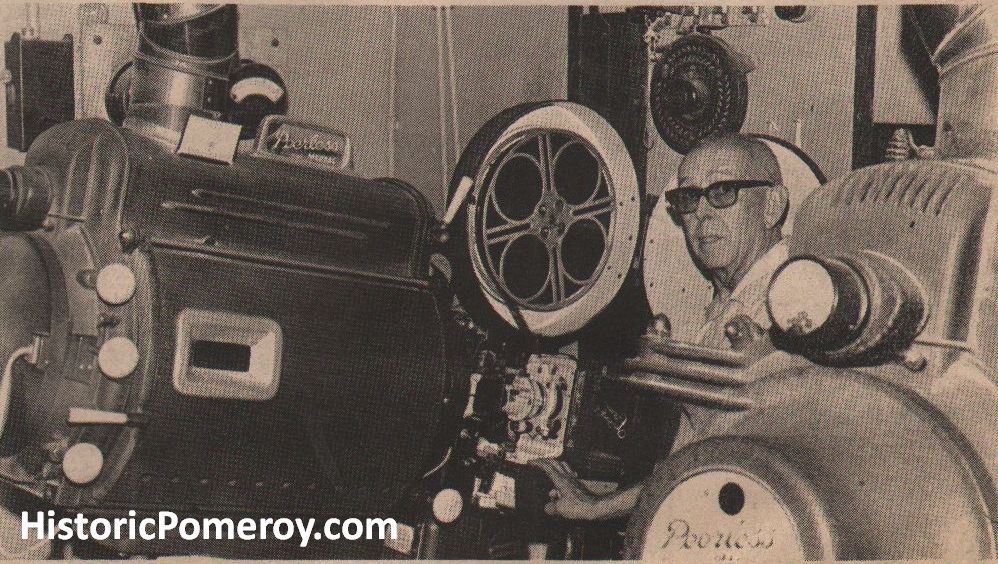
Floyd Koberstein in the projection room
(Mike Denuty photo).
Seeley Allen, grandson of Mr. and Mrs. Seeley, purchased the theatre from Mrs. Thompson on Jan. 1, 1950. He added wide screen and Cinemascope projectors in 1954, but then sold the theatre a year later. He said he regretted having to sell the threatre but wanted to devote full time to the real estate business in Pomeroy and Lewiston. The old boxes along both sides of the theatre were removed when the wide screen was installed.
Mr. and Mrs. Floyd Koberstein took over the theatre of officially on Nov. 1, 1955, although they had operated it the night before for a free Halloween Show. The Kobersteins came here from Pullman, where Floyd had been manager and part owner of the Audian Theatre for a time. He also had been refrigeration maintenance engineer at Washington State College.
Their son, Bill, was 11 years old at the time. He and his wife Karen now have two children. The Bill Kobersteins operated the theatre for a short time, before moving to Pasco.
During the Koberstein "era," the advent of television changed things greatly. The theatre, once the center of entertainment in the community, no longer could be operated every day. Koberstein supplemented his income with a refrigeration shop in the back of the building. He used the old stage lights to illuminate that part of the building. Koberstein also served several terms as county assessor.
Evidence of the old glory days remains. While the Kobersteins closed the balcony in 1967, it still remains, although is not usable. There are also rooms in the back marked "leading lady," "leading man," "principal men/' "chorus," and "orchestra" which date to the days when the theatre offered plays. The one leading to the boiler room has the fanciest lettering. The old Wurlitzer organ was in the theatre until just a few years ago. It is now located at Morgan's Alley.
The theatre was well built in 1913 and while much of the early day glamour is gone, it still has excellent acoustics, and well-designed seating, capable of hosting thousands of movie goers in the years to come.



